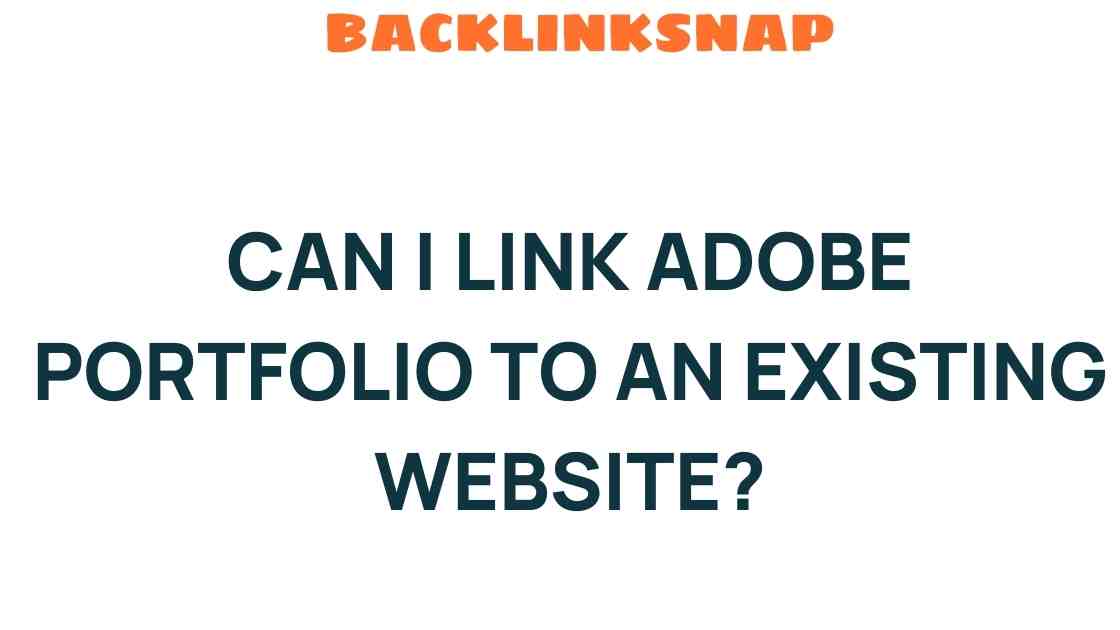Linking Adobe Portfolio to Your Existing Website: A Seamless Integration
In today’s digital age, presenting your work in an appealing and professional manner is paramount. Whether you’re a photographer, graphic designer, or artist, having a digital portfolio is essential. One popular platform for creating stunning portfolios is Adobe Portfolio. But how do you effectively link Adobe Portfolio to your existing website? This article will guide you through the process, ensuring a seamless integration that enhances your online presence and showcases your creative work.
Understanding Adobe Portfolio and Its Benefits
Adobe Portfolio is a powerful tool that allows creatives to build personalized websites to showcase their work. It comes as part of the Adobe Creative Cloud subscription, offering a range of customizable templates and features designed for visual storytelling. Here are some key benefits:
- Ease of Use: Adobe Portfolio is user-friendly, allowing even those with minimal technical skills to create stunning websites.
- Integration with Adobe Products: If you’re already using Adobe software like Photoshop or Lightroom, integration is seamless.
- Responsive Design: Your portfolio will look great on any device, from desktops to smartphones.
- Custom Domains: You can link your Adobe Portfolio to a custom domain, enhancing your professional image.
Linking Your Adobe Portfolio to Your Existing Website
Integrating your Adobe Portfolio with your existing website not only helps in directing traffic but also provides a cohesive experience for visitors. Here are the steps to effectively link your portfolio:
Step 1: Set Up Your Adobe Portfolio
Before linking, ensure your Adobe Portfolio is fully set up and ready to showcase your work. Choose a template that resonates with your style and customize it with your branding, images, and content. Once your portfolio is live, you’ll have a unique URL to work with.
Step 2: Choose Your Linking Method
There are various methods to link your Adobe Portfolio to your existing website:
- Direct Link: The simplest way is to create a direct hyperlink on your existing website that leads to your Adobe Portfolio. This could be in the form of a button or a text link.
- Embedded iFrame: For a more integrated look, you can use an iFrame to embed your Adobe Portfolio directly within a page of your existing website. This allows visitors to view your portfolio without leaving your site.
- Menu Navigation: If your existing website has a navigation menu, consider adding a dedicated tab for your portfolio, ensuring it’s easy for visitors to find.
Step 3: Use SEO Best Practices
When linking your Adobe Portfolio, consider the SEO implications. Use relevant keywords like creative showcase, design portfolio, and of course, Adobe Portfolio in your anchor text. This enhances your website’s visibility in search engines and drives more traffic to your portfolio.
Step 4: Promote Cross-Linking
Encourage visitors on your Adobe Portfolio to explore your existing website as well. You can add links back to your main website in the footer or on specific project pages. This creates a loop that keeps visitors engaged with your content.
Step 5: Monitor and Adapt
After linking, use analytics tools to monitor the traffic flow between your existing website and your Adobe Portfolio. Understanding user behavior can help you make informed decisions about further enhancements or adjustments to your linking strategy.
Enhancing Your Online Presence
Linking your Adobe Portfolio to your existing website is not just a technical task; it’s a strategic move to enhance your online presence. A well-integrated portfolio can significantly improve your visibility, making it easier for potential clients or employers to find and appreciate your work. By employing an effective linking strategy, you can increase engagement, showcase your creativity, and ultimately attract more opportunities.
FAQs About Linking Adobe Portfolio to Your Existing Website
1. Can I use my own domain with Adobe Portfolio?
Yes, Adobe Portfolio allows you to link a custom domain, providing a professional touch to your portfolio.
2. Is it easy to embed my Adobe Portfolio into my existing website?
Absolutely! You can easily embed your portfolio using an iFrame or create direct links, depending on your website’s design.
3. How can I improve the SEO of my Adobe Portfolio?
Use relevant keywords in your project descriptions, and make sure to link back to your main website using strategic anchor text.
4. What are the benefits of linking my portfolio to my existing website?
Linking increases visibility, creates a cohesive user experience, and helps in building a more professional online presence.
5. Can I update my Adobe Portfolio without affecting the link on my existing website?
Yes, you can update your Adobe Portfolio as needed without changing the URL, so your existing links will remain valid.
6. What should I do if I encounter technical difficulties linking my portfolio?
If you face issues, consult Adobe’s support documentation or reach out to their customer support for assistance.
Conclusion
Linking Adobe Portfolio to your existing website is a straightforward yet impactful way to showcase your work and enhance your professional brand. By following the steps outlined in this article, you can create a seamless integration that not only improves your online presence but also provides a rich experience for your visitors. Remember, your portfolio is not just a collection of work; it’s a creative showcase that tells your story. So take the time to integrate it effectively, and watch as new opportunities come your way.
For more information on enhancing your online presence, check out this resource. If you’re looking for tips on building your portfolio, explore this guide.
This article is in the category Digital Marketing and created by BacklinkSnap Team




